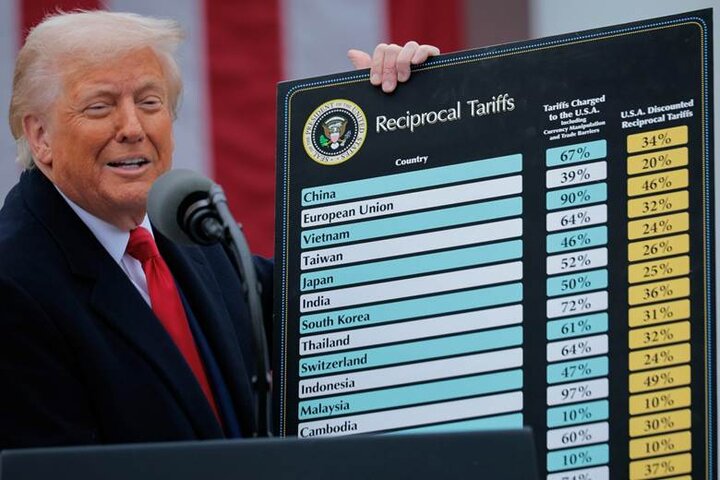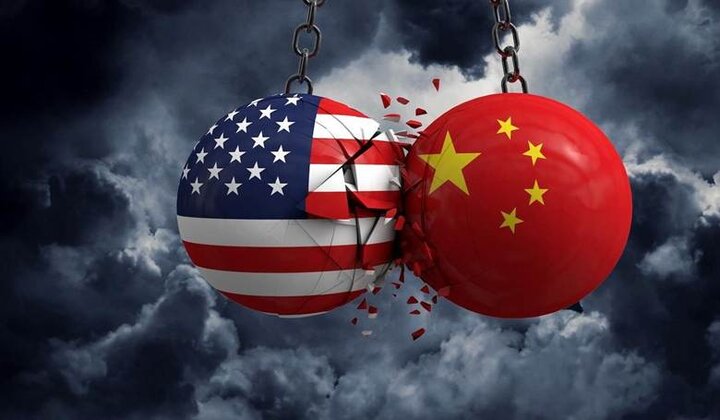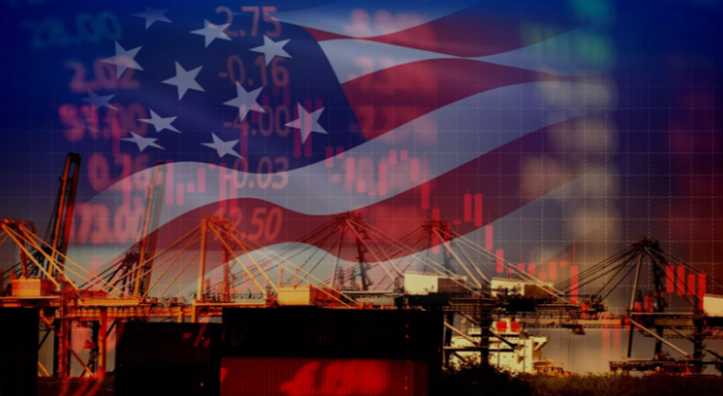The world economy on the edge of the razor; Where does the Duel of Trump and the object come from?

Mehr News Agency , International Group, Hassan Shokouhi Nasab: US President Donald Trump April 2 (April 5) announced a 5 % baseline tariff on all imported goods. The decision that was once referred to as “Day of Freedom” and had widespread reactions.
After Trump’s announcement, some countries and global actors were heavily affected by the tariff war, such as the EU faced a 5 % tariff, while countries such as Vietnam (2 %), Bangladesh (2 %) (2 %) (2 %), Bangladesh (2 %), Bangladesh (2 %) Percent), Taiwan (2 %), Japan (2 %) and Lesoto (2 %) were heavily affected.
Among these reactions, but China’s response to tariffs was more than 100 %, so just a week later, Trump retreated from tariffs on countries around the world and announced that it would suspend tariffs on more than 5 countries for 6 days.

However, Trump did not cancel tariffs on imported goods from China, but significantly increased it to 5 %. In response, the Chinese government also opposed April 5 and increased customs tariffs on American goods by 5 %.
This tariff warfare went so far as the White House issued a statement announcing the total tariffs on imports of Chinese goods up to 2 %; An action that brought tensions between the two countries into an unprecedented phase.
In response to these measures, the Chinese government has put the Chinese large US company on the list of unreliable institutions and increased its efforts to strengthen economic cooperation with the European Union and the Southeast Asian Union (ASA).
These developments indicate that the trade war between Washington and Beijing is expanding not only in the economy, but also on the geopolitical level, and its consequences may affect world order in various dimensions.
The tariff war has affected the American and China economy?
The tariff war between the United States and China has had significant effects on both countries in recent weeks. In the United States, economic growth has slowed down, and the Yale Budget Laboratory report shows that its real GDP has dropped by about half a percent in the first half of the year. This decrease was due to double pressure on companies due to increased import costs, disruption to supply chains and export drops.
simultaneously, US consumers have also faced rising prices in basic commodities; Including goods such as electronics, apparel, home appliances and toys that were previously imported from China at a lower price. An American household, on average, has cost about $ 2 an additional annual cost as a result of these tariffs.
Along with these issues, some key industries in the United States have been severely damaged. For example, American farmers, whose largest export market in China, have now faced a sharp decline in demand and accumulation of crops; Soybean exports, which exceeded $ 5 billion in recent years, have now declined less than half.
Automotive is also one of the other parts that have not only faced increased costs of imported parts, but also lost the export market to China. These problems have led American car giants such as Ford and General Motors to stop part of their production lines or adjust workers.
Great market analysts have warned that the continuation of this trend could enter the US economy by the end of the year, and the recent decline in stock exchanges is confirming these concerns.

On the other side, the Chinese economy has not been spared the consequences of this trade war. The analysis of the Goldman Sachs Bank shows that China’s economic growth has reached 5 % this year, the lowest in the last two decades. Reducing exports to the United States, dropping domestic demand, and reducing private sector investment are key factors in this downtrend.
Yuan’s value has also fallen to its lowest level since year 6, making the import of raw materials more expensive and complex for Chinese manufacturers. Meanwhile, millions of Chinese workers working in the export -oriented industries have been threatened by unemployment; Because export orders have declined and many factories have been forced to reduce production or adjustment.
China has also tried to reduce its dependence on the US market by expanding its export markets to other countries such as members of Assean, Africa and Latin America. But this is not a simple replacement. Emerging markets have both limited capacity and fierce competition between exporters from different countries. As a result, Chinese companies have had to launch their products at a lower price that have put their profitability.
These internal pressures, along with external consequences, have darkened China’s economic outlook like the United States, and many analysts believe that if there is no solution to stop this trade war, not only China will suffer heavy damage.
Washington-Pack Tariff War Alarm for the World Economy
The tariff war between the United States and China, as the two large and extremely intertwined economies in the world, has had significant impacts on the world trade process. With the increase in tariffs, free flow of goods and capital was impaired, and global supply chains, especially in the field of technology, automotive, medicine and consumer goods, were instable. These changes have forced multinationals to redesign their supply chains.

One of the most important consequences of these tensions is the increase in global inflation. When tariffs apply to basic and technological commodities, the cost of imports for many countries, especially developing economies, increases. Following that, prices rise in the domestic market and the pressure on the end consumer increases. Even countries that are not directly involved in this tariff war are affected by precious, commercial and currency channels.
at a larger level, this war has slowed global economic growth. The IMF and the World Bank have reported in several reports that these tensions could reduce the world’s GDP by up to a few percent. Reducing exports, mistrust in investment space, and corporate retreat from international projects have slowed the growth of raw materials exporting countries and intermediary goods.
structurally, tariff warfare has accelerated the “economic worldwide” process or decline in world trade dependence. Countries have become more inclined to boost their domestic production or find new business partners to prevent similar geopolitical risks. This may lead to a global economic structure in the long run, but in the short term it will increase costs, reduce efficiency and more instability.
Finally, the impact of the tariff war is not just economic. These wars can weaken international organizations such as the World Trade Organization (WTO), exacerbate regional competitions, and create the basis for future political and military confrontation. Under such circumstances, the global economy will move towards a period of further uncertainty and lower growth unless the tensions go back to negotiation and cooperation.
observers, continuing or exacerbating trade tensions between the United States and China, is not merely a bilateral economic difference, but a profound threat to the global economy and geopolitical order.
When the two major economies of the world enter a cycle of tariffs, sanctions and trade restrictions, its consequences are not limited to the borders of the two countries. The global supply chain is damaged, international production and trade are disrupted, and many countries relying on exports and imports will be stagnant. According to institutions such as the IMF and the World Bank, a full -fledged trade war can reduce the world’s GDP in the long run.
In addition, raw material exporters suffer the most damage from this situation because of their high dependence on world trade. In addition to economic downturn, severe inflation, instability of financial markets, increased economic pressure on consumers, policy -making in economic decisions, and even the possibility of expanding conflicts to non -economic areas are among the worrying consequences of such a crisis. Therefore, the trade tension between the US and China is not just an economic challenge, but a pervasive threat to global stability.
to prevent the spread of this crisis, experts believe that the parties should return to the negotiating table and move towards multilateral agreements with European, Asian and international institutions. Also, supporting the affected industries through financial facilitation policies and diversification to global supply chains can reduce the risk of over -dependence on a particular country.


